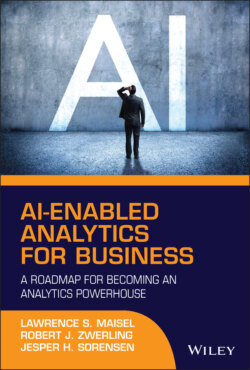Читать книгу AI-Enabled Analytics for Business - Lawrence S. Maisel - Страница 21
Group Decision-Making
ОглавлениеSeveral recognized behavioral group decision-making processes occur in forms that are considered flawed because they contain bias. They lack the tools of analytics to inject unbiased insights into the decision process. One of these occurrences is often referred to as the Abilene paradox, where a group of people collectively decide on a course of action that is counter to the preferences of many or all of the individuals in the group.4 It involves a common breakdown of group communication in which each member mistakenly believes that their own preferences are counter to the group’s and, therefore, does not raise objections. A common phrase relating to the Abilene paradox is a desire to “not rock the boat.”
For example, the design team of a successful smartphone is deciding whether to remove the home button on its next version release. The lead designer suggests that the home button be kept, and the decision, after some discussion, is to keep the home button. Later that day, some of the design team meet for lunch, and Peter expresses his preference for removing the home button. Mickey jumps in to say “Me too!” and is followed by Davey. They all acquiesced to the decision since they believed they were the only ones who did not agree. In fact, when the team reassembled, most of the other members also preferred to remove the home button but also did not express their preference.
Another group decision-making process is groupthink, a mode of thinking in which individual members of small cohesive groups tend to accept a decision that represents a perceived group consensus, whether or not the group members believe it to be valid, correct, or optimal.5 Groupthink reduces the efficiency of collective problem solving within such groups and perpetuates bias and flawed assumptions.
For example, a capital project review team is convened to decide on next year’s CapEx budget. Each member is asked to indicate their preferred #1 project. After the first and second members express their preference for the same project, each succeeding member agrees with the first two, although their individual preferences were different. They “go along to get along” and express their agreement with the preferred project.
Ronald Sims writes that the Abilene paradox is like groupthink but differs in significant ways, including that in groupthink, individuals are not acting contrary to their conscious wishes and generally feel good about the decisions the group has reached.6 According to Sims, in the Abilene paradox, the individuals acting contrary to their own wishes are more likely to have negative feelings about the outcome. In Sims’ view, groupthink is a psychological phenomenon affecting clarity of thought, whereas in the Abilene paradox, thought is unaffected.
These group decision-making processes demonstrate the embedded flaws in human behavior that can produce decisions that lead to under-optimized, inefficient, ineffective, or non-competitive business performance that wastes capital and resources. This punctuates why unbiased, scientific AI and analytics inputs are essential to minimize or eliminate group bias and contribute to improved business performance.
